Yacine Adli (186cm/6’1”, 78kg/172lbs) joined Serie A giants AC Milan last summer for a reported €8m and a season-long loan back to the club he’d been signed from for 2021/22 — Ligue 1’s Girondins de Bordeaux.
The 21-year-old playmaker joined Bordeaux from PSG 31 months before this Milan transfer, in January 2019, for an alleged €5.5m fee, having rejected a move to EPL side Arsenal a year and a half beforehand at a time when the Gunners were under the tutelage of Unai Emery who’d previously given Adli his Ligue 1 debut for Les Parisiens.
Adli has steadily grown throughout his time at Matmut Atlantique.
This season, he’s been a key figure in the southwestern club’s relegation battle, with much of the team’s play moving through him.
This growth in the team was not by accident.
In late-2021, the young Frenchman revealed in an interview: “When a club like Milan signs you, you want to go there right away but this year will serve me to prepare myself in a better way.
I also want to help Bordeaux have a good season.
The coach waits for me to be more decisive.”
This increased decisiveness has been evident in Adli’s play this season.
The 21-year-old has improved his bravery on the ball and displayed more leadership qualities on the pitch.
He’s currently Bordeaux’s chief creator, with only seven players making more Ligue 1 assists than Adli (six) this term.
The creator ranks second among Ligue 1 midfielders for assists in 2021/22, only trailing Dimitri Payet.
While his importance has increased on the pitch, this has seemingly also been the case off the pitch, with Adli picking up the captain’s armband in recent weeks after ex-captain Laurent Koscielny was let go last month.
All in all, it appears as though Milan has got a maturing leader on their hands set to join I Rossoneri later this year, but what exactly can Milan fans expect from their soon-to-be new midfielder?
This tactical analysis and scout report aims to provide
an in-depth analysis of Adli’s role within Bordeaux’s strategy and tactics this season and highlight what he hasto offer his new club.
Adli is a highly versatile player with a diverse skill set that could make him well-suited to several different positions or tactical roles upon arrival in Italy. His work rate and leadership qualities also make him an exciting prospect as he continues his development.
I hope that this scout report provides Ligue 1 fans, Serie A fans and any other readers with a clearer picture of what Adli brings to the table and what makes him tick as the hub of struggling Bordeaux’s creativity this season, driving their ongoing relegation battle.
Creativity in advanced areas
Adli’s passing and off-the-ball movement to receive passes are, for me, the most interesting aspects of his game, so much so that I’ve decided to split this aspect of his game into two separate sections in this tactical analysis piece — ‘creativity in advanced areas’ and ‘creativity in deeper areas’.
Firstly, I’ll take a look at Adli’s propensity for creating in more advanced areas.
As already mentioned, the PSG academy product has been his side’s main source of creativity this season.
The extent to which Adli has been vital to his team’s chance creation this season is evident in the fact that, per Understat, he’s got by far the highest xGChain (9.06) of any Bordeaux player.
This statistic assigns an xG value to a player for every possession they’re involved in and Adli’s is almost twice as high as any other Bordeaux player.
This gives us an indication of his impact on possession and his central role in Bordeaux’s system.
As previously mentioned — a lot of Les Girondins’ play flows through Adli, resulting in this high xGChain.
Additionally, though, this does also give us a positive indication that when Adli is involved in his team’s play, the possession tends to be a more dangerous one, which I’d attribute to the player’s impressive levels of creativity.
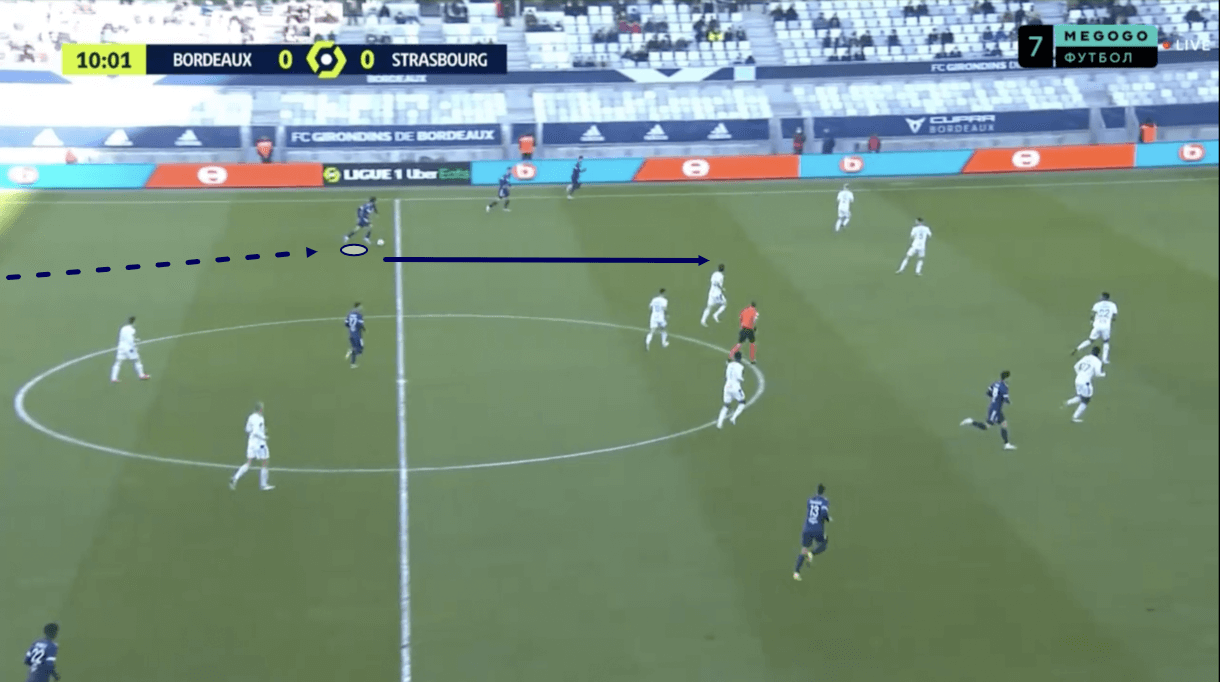
While this section of analysis intends to focus on Adli’s creativity in advanced areas, it’s really common to see him picking up the ball in deeper areas, as was the case in figure 1 here.
In Bordeaux’s system, which relies heavily on him and his creativity, the playmaker, who typically plays as either one of the ‘number 8s’, a ‘number 10’ or a left-winger, will frequently drop deep to collect the ball from the centre-backs or even to drop between the centre-backs and collect from the goalkeeper.
From there, while Adli is a great progressive passer and a long passer, which we’ll come onto later, he’s also a great ball carrier and it’s common to see him backing his ball-carrying ability to drive his side upfield and into the final third with the ball at his feet.
In the image above, Adli dropped deep from his ‘10’ position versus Strasbourg to pick up the ball from his centre-back teammate before quickly turning and driving into the opposition’s half casually with the ball at his feet.
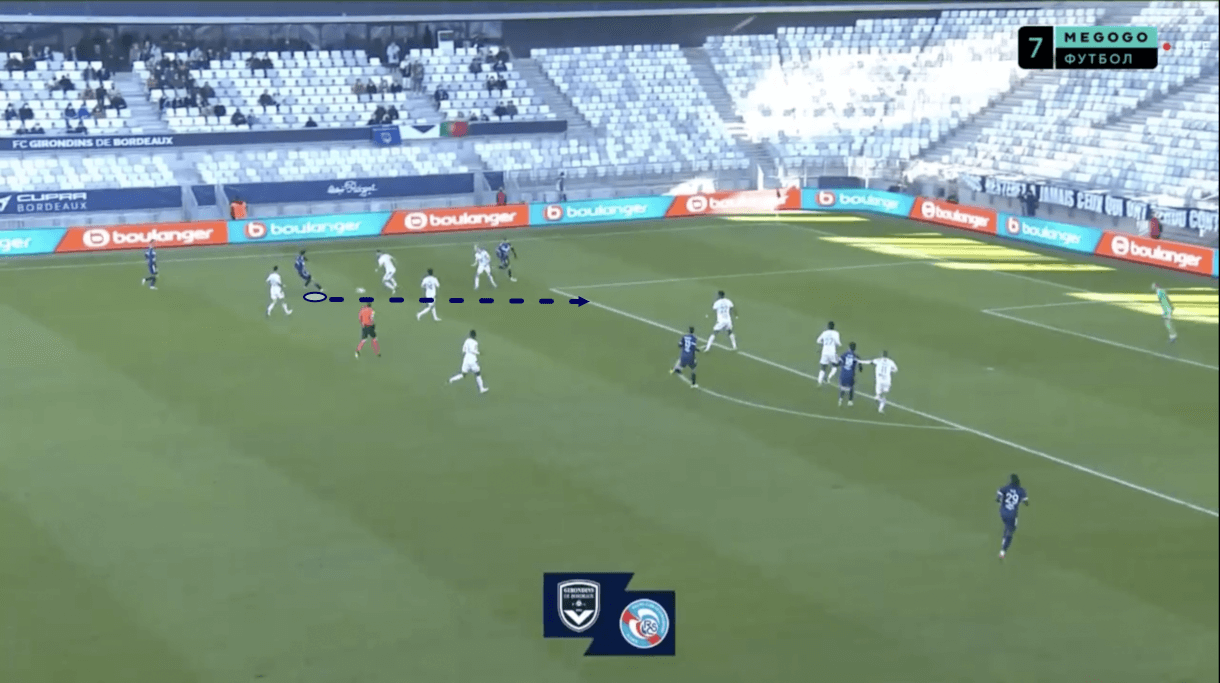
As play moves on into figure 2, we see that Adli made it to the final third before really attracting significant pressure from the opposition and positioned himself in the left half-space before sliding a through pass between the tight trio of defenders in front of him to release his left-wing teammate in behind the opposition’s backline.
This run from deep into the final third is a big part of Adli’s game — he loves to pick the ball up deep and drive forward with it.
In general, the Bordeaux man thrives when he’s got space to drive into and struggles more when crowded around, especially in deeper areas where he’s typically keen to get the ball upfield quickly and can be more prone to risky touches.
Furthermore, this punched through pass aimed to break the lines despite having plenty of closely-positioned players to get the ball through is a trademark of Adli’s game.
He is excellent at finding a way to punch the ball through extremely tight spaces and into his teammates’ path, as we see in figure 2 with this particular pass coming at the end of a long run upfield.
Adli’s ability to spot and find a way through such tight spaces in the opposition’s backline with his creative passing quality is a major asset for Bordeaux that should excite Milan supporters.
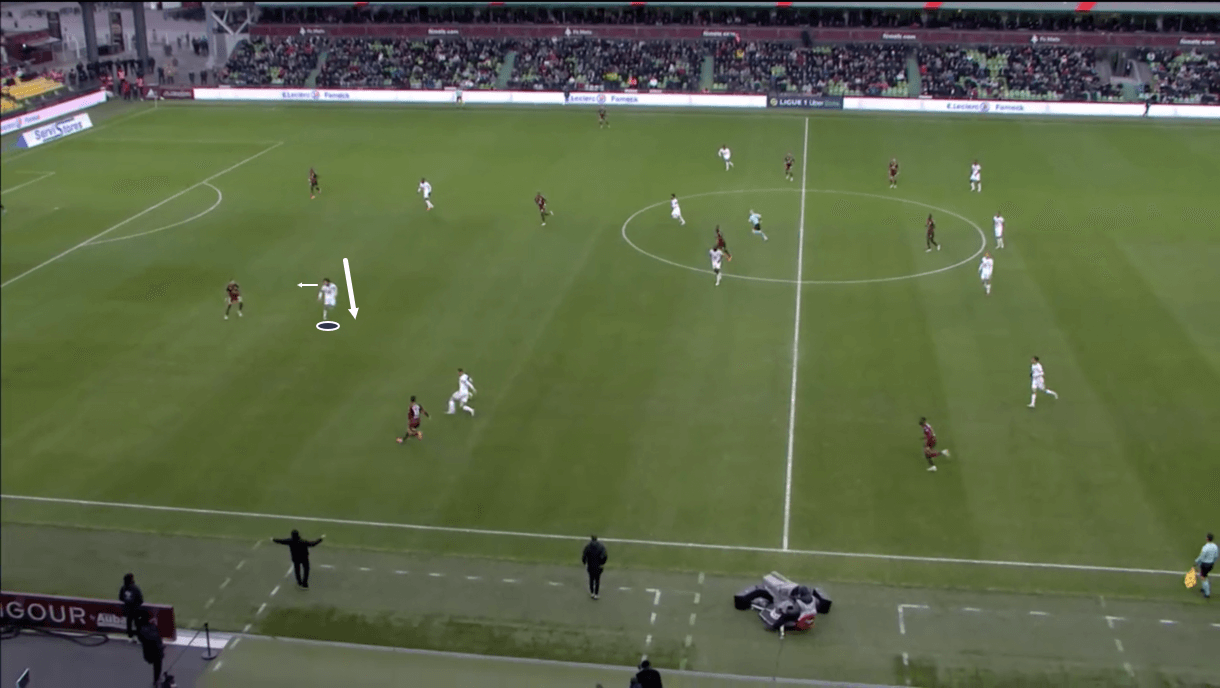
Adli doesn’t exclusively pick the ball up in deeper areas, however, he is still generally an attacking midfielder, at the end of the day.
As a result, it’s very common to see him occupying the kind of position we see in figure 3 — just inside or just on the edge of the final third, having found a pocket of space to operate from via his off-the-ball movement.
Typically, Adli looks to position himself in the half-space, especially the left half-space.
From here, he can create either via a through pass, a passage of link-up play with a teammate or a dribble.
It’s also common to see Adli try to cut inside onto his stronger right foot from this kind of position before performing his next action.
In figure 3, we see the midfielder dropping into the left half-space to offer his left-winger a short passing option in a slightly more advantageous position.
As he approaches this teammate, we see Adli diligently scanning over his shoulders in intelligent moments.
For example, here, we see him checking his right shoulder just a second after the left-winger took a touch to change direction.
This was an intelligent time to scan as it was in between the teammate’s touches when the ball was already moving, making it an optimal time for scanning as the ball is not changing direction at this moment, so he isn’t going to miss a major moment in the play by turning his head away.
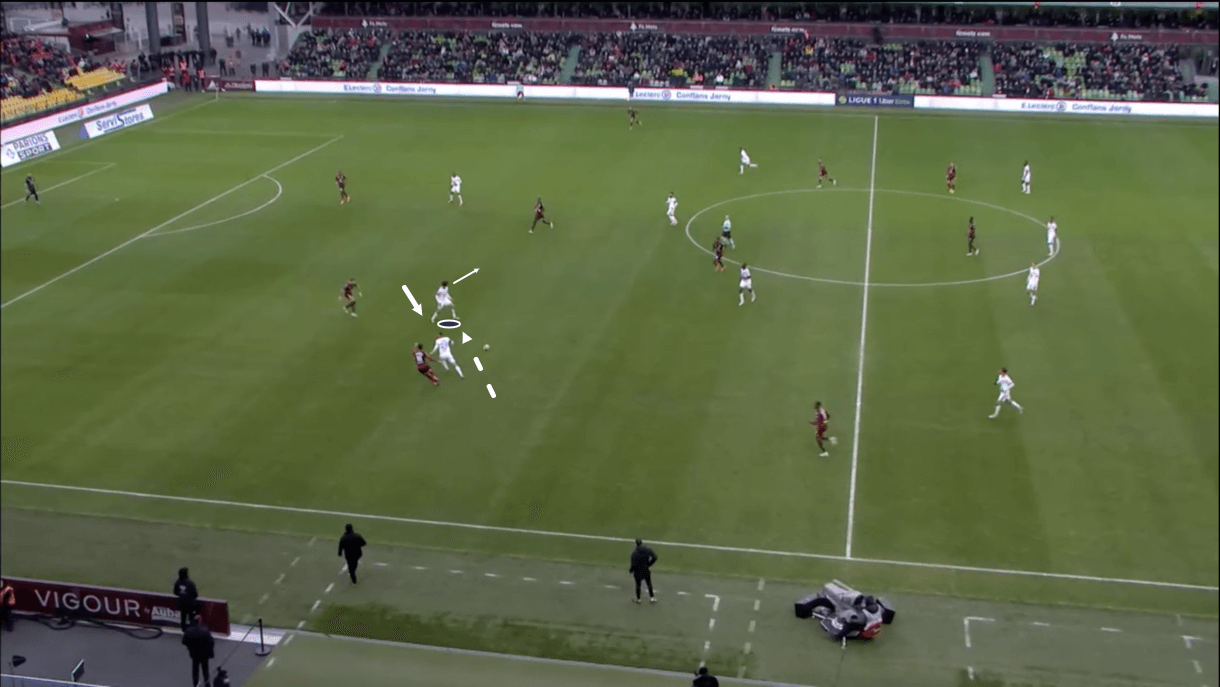
After moving his focus back to the man on the ball until the pass is played, Adli again performs an intelligent scan, this time over his left shoulder, after the pass is played.
Again, here he’s already processed all of the information in front of him that he needs to receive the pass — he saw the pass get played and knows the angle, speed, etc at which it’s approaching him.
As a result, he can safely use the time before it arrives to quickly scan over his left shoulder, which is what happens in figure 4.
The scanning in figures 3 and 4 helped Adli to receive the ball safely with greater knowledge of how the rest of the field is laid out around him, including behind him.
This is useful and aids his decision-making process ahead of his next move as he now has a clearer picture of how the rest of the field looks, both in terms of teammates’ positioning and movement as well as opposition players’ positioning and movement.
As play moves on from here, we see Adli receive and exit on his left, where he has more space to turn into than on his right, as is evident from the images above.
This shows how his decision-making was helped through his scanning and now, Adli can focus on executing his next move after giving himself as much time and space as possible to do so.
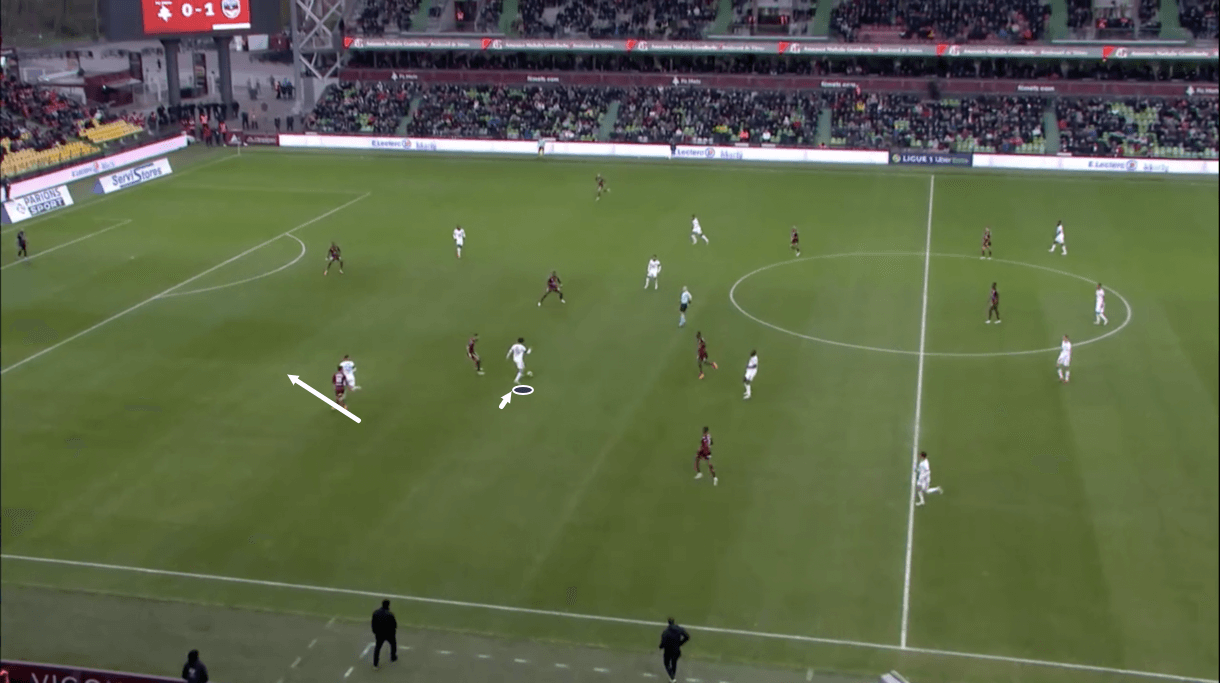
After receiving the pass and turning out into the centre of the pitch on his left side, figure 5 shows how Adli gets his head up and starts to shape his body as if he’s intending to play a pass into the centre-forward.
Meanwhile, it’s worth noting at this point that the left-winger who’d initially passed the ball to Adli is now running beyond the defensive line, making himself available for Adli’s through pass.
The soon-to-be Milan man loves to be in this kind of situation, similar to the one we saw him in back in figure 2.
Adli loves to be in the final third with a runner ahead of him and defenders closing him down.
He feels comfortable under pressure and enjoys creating additional space for teammates via his dribble, while he also loves to fire through balls to the runners from this position, which is why he’s played 2.79 through passes per 90 this term, per Wyscout — the fifth-most of any Ligue 1 central midfielder/attacking midfielder to have played at least 500 minutes in 2021/22.
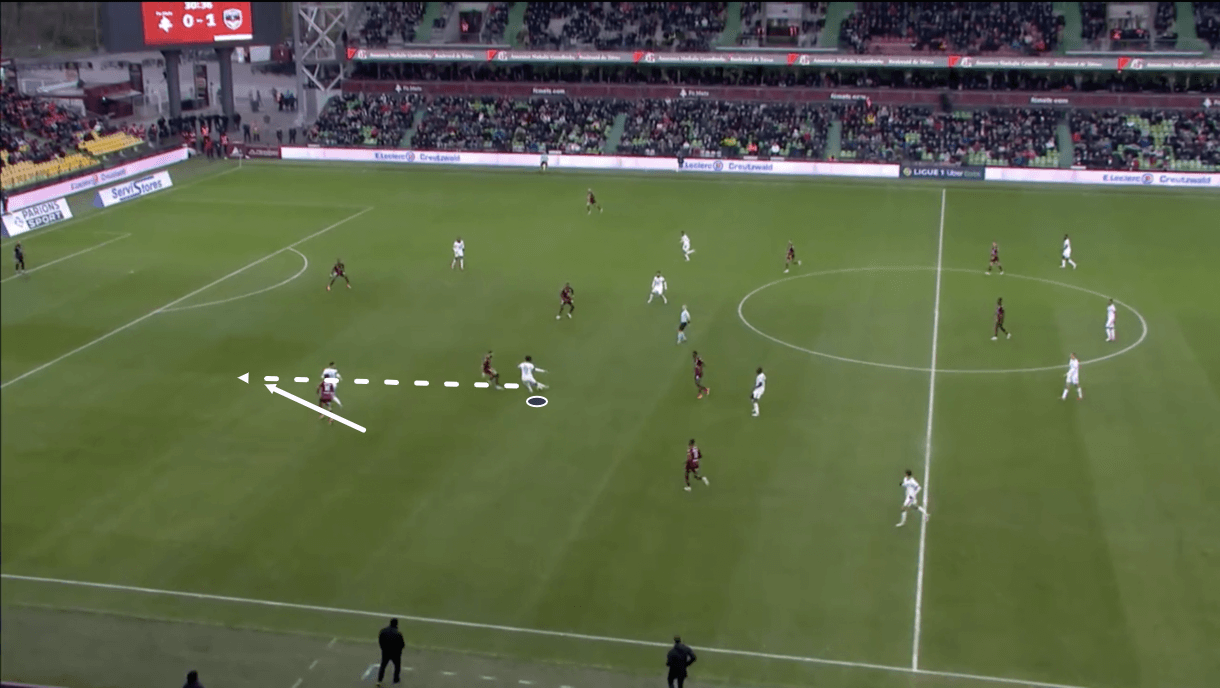
As play progresses into figure 6, we see Adli aim his through pass into the left-sided runner’s path despite his body being shaped as if he’s going to send the ball into the centre.
This required excellent vision and good anticipation to prepare himself so far in advance to disguise the pass as he did so successfully while still keeping an eye on the runner and choosing the right time to release him behind the opposition’s backline.
Disguising the final pass like Adli did here is a strong part of the attacking midfielder’s game and something we see him do successfully quite often.
Body shape is one way of doing this, as we saw in this particular example.
Another common example of this is Adli cutting in from the left wing onto his right foot and then immediately playing the through pass, with little backlift, to his left.
Adli is excellent at playing devastating creative passes without a lot of backlift and essentially without telegraphing the pass very much at all.
Teammates need to be aware of this because it is a great tool at disguising his passing intent but as a result, can be difficult even for them to anticipate unless they’re familiar with this element of his game.
If they do make themselves familiar with this part of his game, however, this can be a great tool in the playmaker’s arsenal.
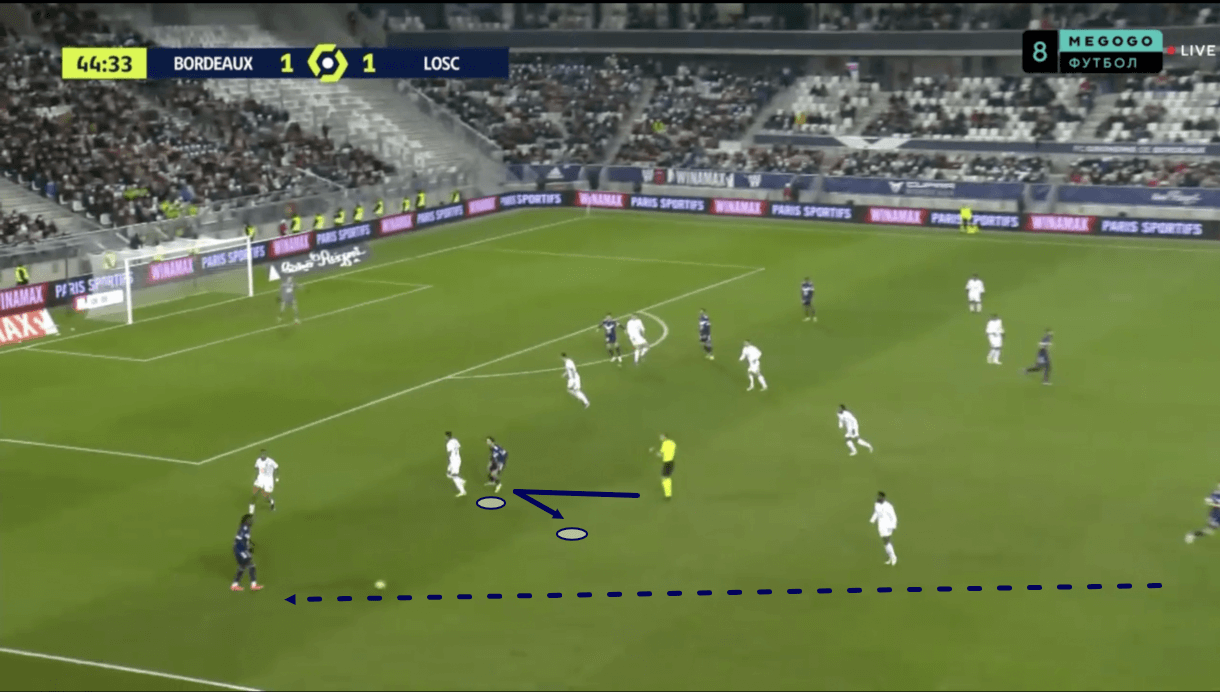
Lastly, for this first section of analysis, I want to focus on Adli’s intelligent, subtle movement inside the final third to make himself available to receive passes.
Figure 7 shows an example of one such occasion when Adli subtly peeled away off the defender’s shoulder inside the final third to become a more attractive passing option.
Here, Bordeaux’s left-winger is receiving a pass to feet while Adli is in the left half-space, just behind the defender.
As the winger receives the ball, the 21-year-old notices the increased amount of space just behind him and jolts back into that space, losing his marker and making himself available to receive the ball in the half-space from the winger.
From there, Adli enjoys time and space to turn towards goal, face the opposition backline and create a goalscoring opportunity, highlighting the creative impact of this intelligent, subtle movement.
Adli’s off-the-ball movement is a joy to watch and helps to make him excellent when it comes to receiving passes, making himself available for teammates and opening up viable passing lanes.
Creativity in deeper areas
While the previous section shows what Adli can offer his side as a creator in advanced areas, such as on the edge of the final third, he’s also proven to be a solid asset for Bordeaux in deeper areas at times this season.
Per Wyscout, he’s made a relatively high number of progressive passes (7.72 per 90) and a relatively high number of progressive runs (1.98 per 90) when compared to other central midfielders and attacking midfielders in France’s top-flight this term.
Indeed, Adli is comfortable with receiving and playing in deeper areas, despite often playing as one of his team’s more advanced players.
He’s comfortable operating as an ‘8’ but is also comfortable simply dropping into the deeper central midfield area when starting as a ‘10’, adding a third body to this area to overload it and receive from the backline.
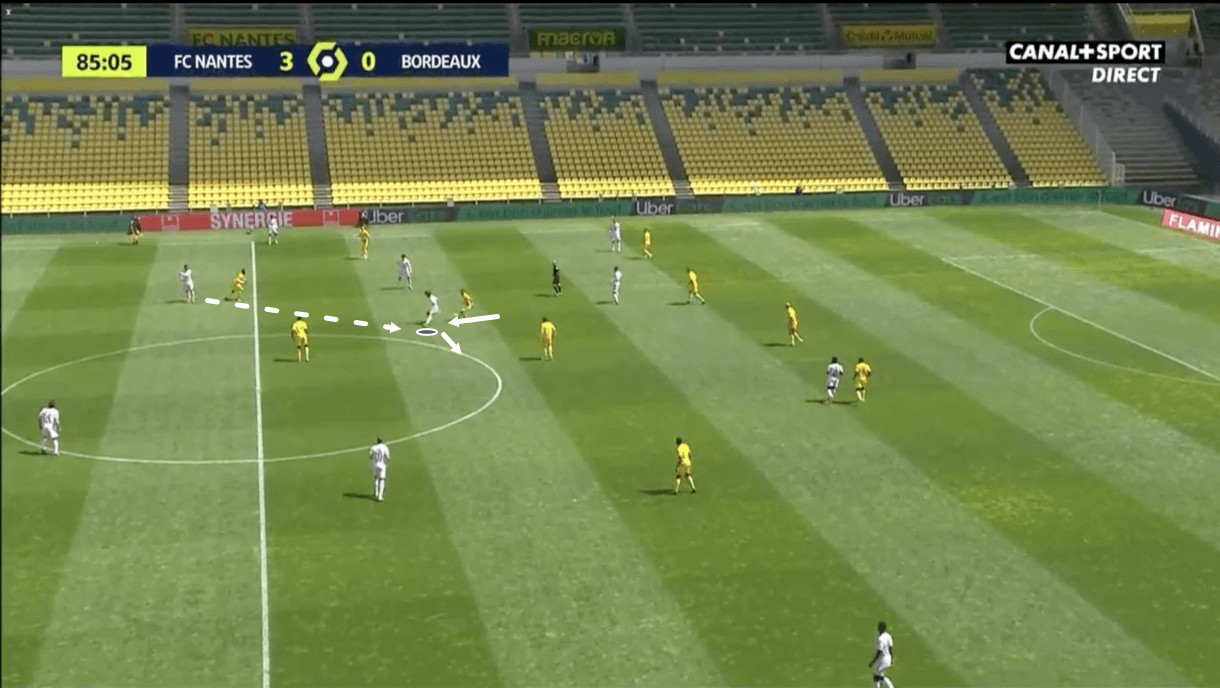
We see an example of this in figure 8, where Adli dropped between the two deeper midfielders behind him to create a new passing lane for the left centre-back to play through, as we see in this particular example.
One attribute that makes Adli an asset in such situations is his ability to receive on the half-turn.
The creative midfielder is capable of turning quickly and sharply on receiving the ball, helped by his mobile hips, to change direction and link the backline to the forward line.
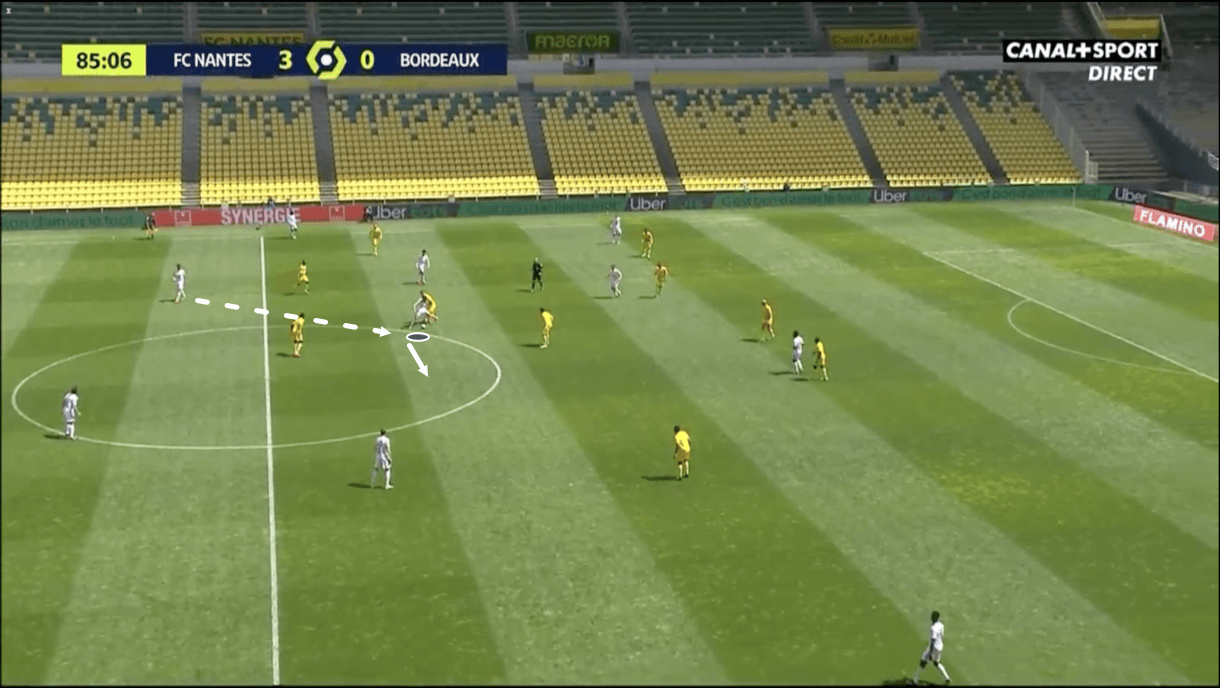
Moving into figure 9, after dropping deep and receiving this pass, Adli attracted some aggressive pressure from an opposition midfielder who got tight to him and attempted to prevent his continued progression.
However, the Bordeaux man dealt with the situation well, adopting a solid, wide stance by spreading his feet apart and getting his hips low.
This helped to keep the defender at bay while protecting the ball and making it more difficult for the defender to move him and, most importantly, dispossess him.
From here, Adli was able to set himself before breaking free into the space on the right side of central midfield, just in front of him here which he had already begun turning into.
This then set up a good penetrative passing opportunity for the 21-year-old, all resulting from his initial move into a deeper area, ability to receive on the half-turn and excellent body positioning to hold off the pressing player.
Adli is capable of pulling off moves like this regularly when receiving in deeper areas and the aforementioned traits we’ve analysed here all make him a solid asset for his team in the progression phase.
However, Adli does have some weaknesses that can be targeted in this particular phase of play as well.
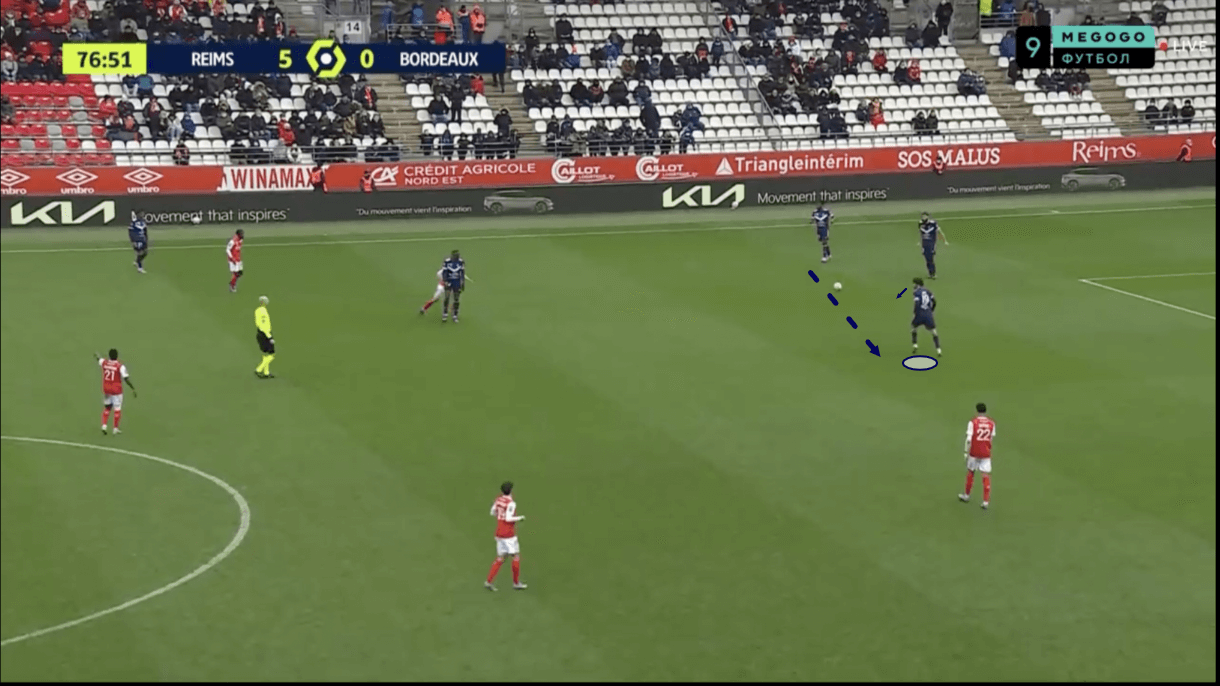
Figures 10-11 show one example of how Adli can be targeted in the progression phase.
Firstly, in figure 10, we see the midfielder has once again dropped deep to receive from the backline.
Again, we see Adli scanning intelligently here, ensuring he checks his shoulder as the ball is moving towards him — an excellent time to make this decision as the ball is moving and he knows where he needs to be to receive it.
He can then use this time while the ball is travelling to survey the situation around him, giving himself as much useful information as possible before receiving and needing to decide on his next move.
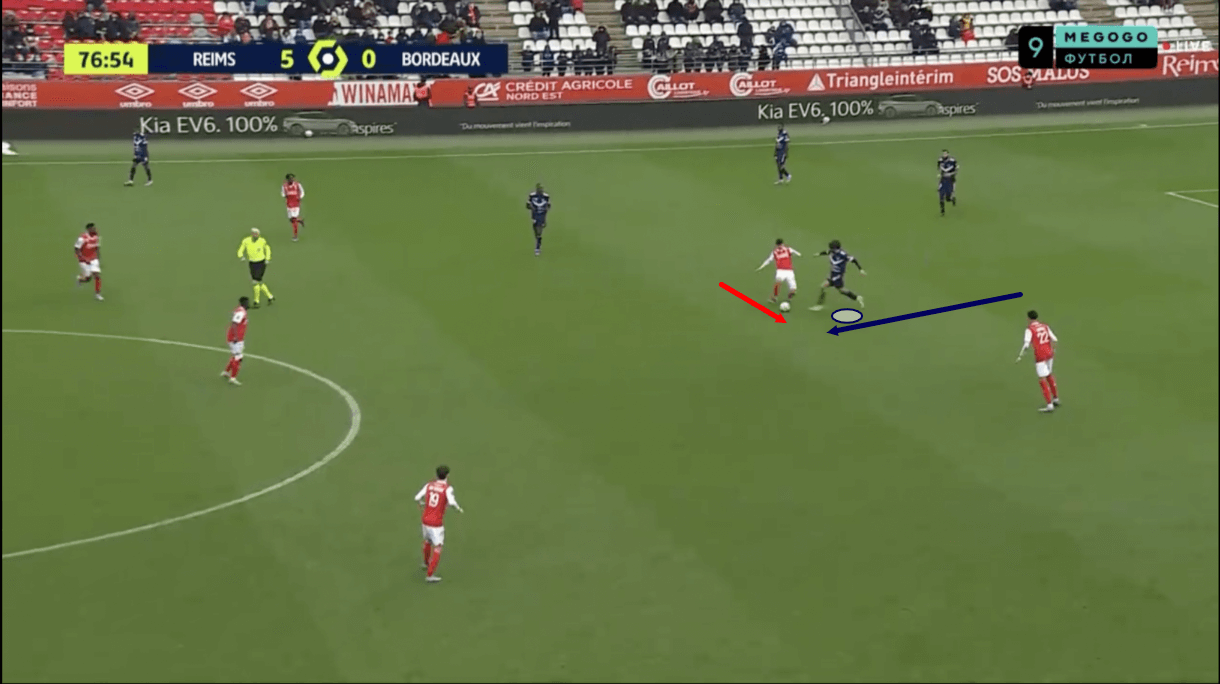
The Bordeaux player receives well here, again taking the ball on the half-turn, quickly reorientating himself to face the business end of the pitch and then starts driving forward with the ball, as we see in figure 11.
As we saw and discussed earlier in this tactical analysis piece, Adli loves to drive his team upfield via carries too, not just passes, and this was the case in the example shown.
This is often how Adli opts to approach passages of play when he receives the ball very deep.
While he’s comfortable with making long passes and acting as a deep-lying playmaker at times, he’ll often receive in a deeper area with few viable passing options ahead of him and space to charge into.
This space to drive towards is what Adli is primarily always looking for; first and foremost, he thrives as a progressive carrier driving into space.
Just like when he carries the ball forward into space in the final third, Adli loves to draw pressure from opposition players towards him when carrying the ball forward in deeper areas.
However, this can naturally be riskier in deeper areas for a couple of reasons: 1.
The risk of a dangerous counter-attack occurring if the ball is lost is far greater in a deeper position simply due to the close proximity to their own goal, 2.
The pitch is far more open at this point and Bordeaux typically don’t build with lots of players packed closeby, resulting in not as many immediate passing options becoming apparent when carrying the ball in deeper areas compared to when carrying the ball in more advanced areas, as seen previously in this scout report.
Furthermore, while Adli is a technically proficient dribbler, as we’ll analyse in the next section of this tactical analysis piece, he’s not very quick, yet he can sometimes take strong touches when carrying the ball forward from deep positions as he looks to drive forward into space.
Due to this, quick opposition players can prey on his heavy touches and target them as pressing triggers to simply beat the 21-year-old to the ball and dispossess him.
Ultimately, Adli can sometimes bite off more than he can chew when carrying the ball in deeper areas.
Again, he has plenty of positives in this area of his game, including his ability to receive on the half-turn and his off-the-ball movement to find space and provide a passing option, but his tendency to carry dangerously can create unnecessary risks in this area too and some weaknesses can be exploited when doing so.
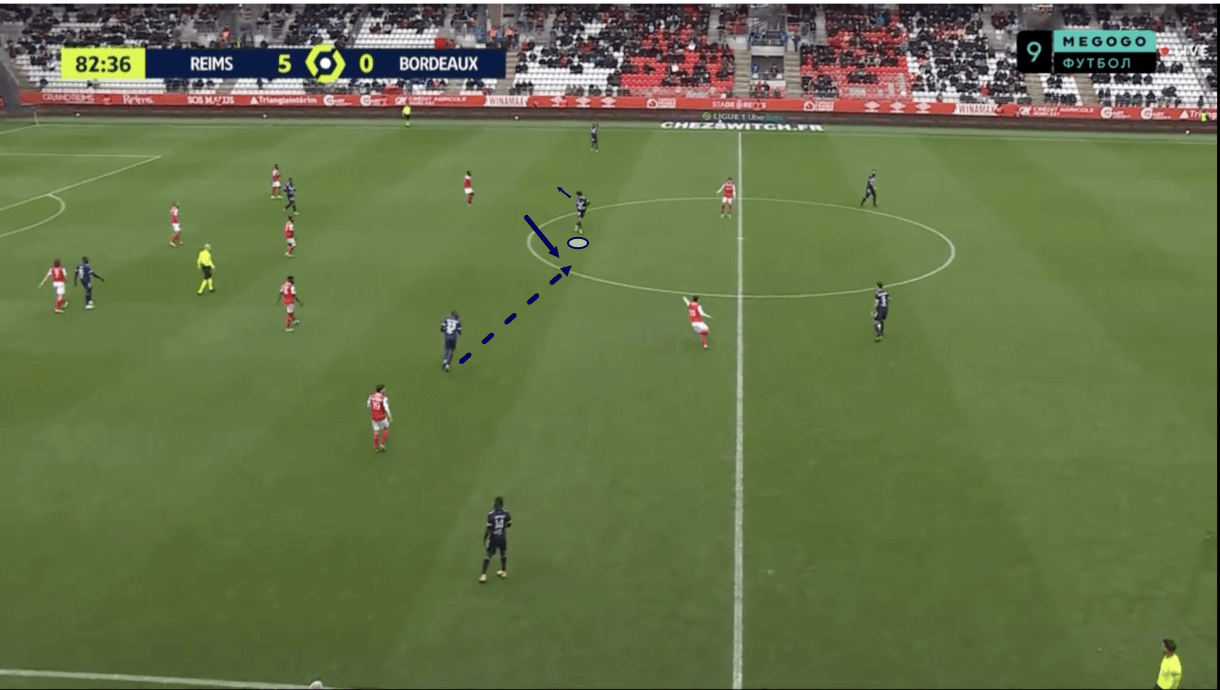
Figures 12-13 share another example of Adli picking up the ball in a deeper, central midfield position from this recent 5-0 loss to Reims.
Here in figure 12, we see Adli receiving inside the opposition half during the chance creation phase, while operating just in front of the backline.
Adli’s ability to find space, receive on the half-turn, scan intelligently and generally progress his team upfield all help in this area but I don’t think this is where he should be positioned in the chance creation phase.
A problem for Adli at Bordeaux this season has been that a lot has been asked of him.
He’s largely risen to the challenge and acted as the star man for his side in their relegation battle, following Bordeaux’s financial issues that have fuelled their on-the-field struggles this term, but I think asking so much of him, while being a worthwhile developmental experience, is leaving him in unfavourable situations too often.
Again, he’s got the ability to excel in a position like this thanks to the aforementioned qualities but this isn’t his ideal area of operation and as such, he’s more likely to get exposed when operating here, as sometimes required at Bordeaux.
If Adli had a more specific role where he just focused on operating further upfield, for example in the left half-space during the chance creation phase, while it’d limit him in some ways I feel it would ultimately free him to create within a certain set of rules in which he’d end up thriving even more.
At present, with so much being asked of him, he’s not always put in the best possible situation to succeed himself.
As he drops to find space to receive in figure 12, we again see him intelligently scanning very quickly to ensure he’s got space to receive and turn.
He performs this check of the shoulder as his teammate is in between touches.
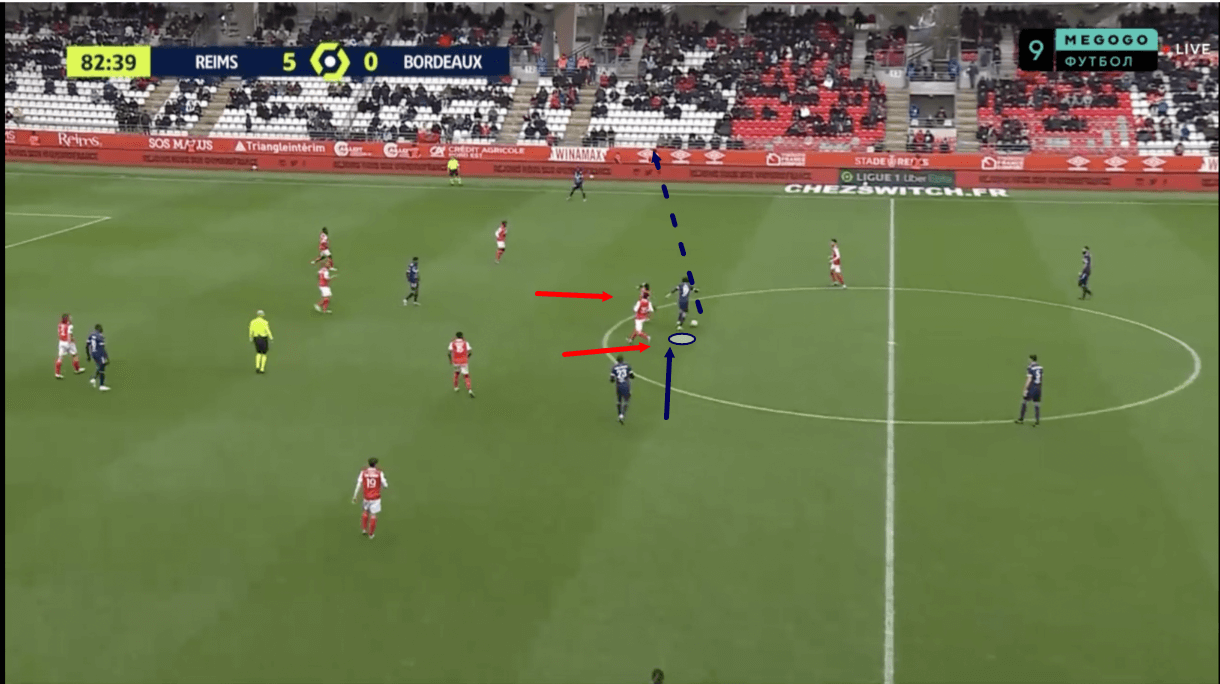
On receiving here, Adli yet again shows his excellent ability to receive on the half-turn and shapes his body to spread the play out to the right-wing.
However, he takes his time between receiving and passing — again showing his tendency to hold onto the ball and attract significant pressure before releasing.
However, this doesn’t work out on this occasion as the pressing players keep the near passing options in their cover shadows while closing down Adli and the full-back nearest to the wide passing option retains access to his man.
This leads to Adli simply putting himself under more pressure without a better passing situation available.
As play moves on from figure 13, we see the under pressure midfielder send the ball out for a throw-in to the opposition, a misplaced pass likely in part resulting from the unnecessary amount of pressure that built on him.
Adli can operate as a deep-lying playmaker comfortably in the future but I feel he has some developing to do before this becomes a natural area for him.
At present, he treats this position similarly to how he treats operating in more advanced areas which can put his team under too much pressure at times.
The Bordeaux man is an excellent progressive passer and carrier but I feel he’s at his best in the progression and chance creation phases when using his impressive off-the-ball movement to find and exploit space and receive passes in more advanced areas — another important skill for players to show in this phase which Adli arguably shows better than anyone else at Bordeaux — and then create from a more advanced position, as we saw in the first section of analysis in this scout report.
Dribbling quality
Adli has made 4.29 dribbles per 90 this term and achieved a 62.5% dribble success rate, with both of these numbers ranking the Bordeaux man impressively among Ligue 1’s midfielders and attacking midfielders to have played at least 500 minutes this term.
The playmaker is a solid passer, as seen in the previous section, and progressive carrier when driving into space from deep but he’s also good in offensive 1v1s with impressive agility, footwork and a good change of pace in his arsenal to beat defenders, hence why he’s been so successful in this area for Les Girondins this term.
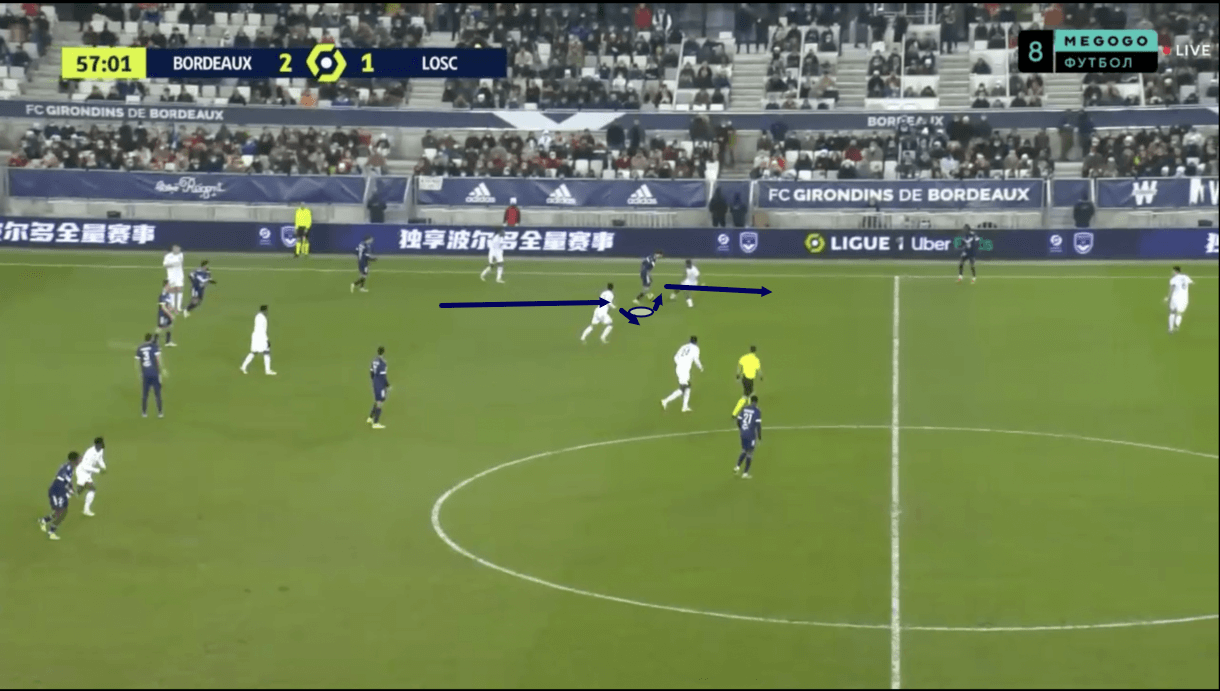
Firstly, figure 14 shows an example of Adli approaching an opposition defender out wide, having just received the ball from the backline, turned and started to drive forward.
Just before this image, the midfielder put his weight on his right side, influencing the opposition defender to move his weight and body shape to protect the centre.
After influencing the defender into making this move, Adli shuffled the ball between his feet, gracefully moving it from right to left in a seamless motion to exploit the side of the defender that is now under-protected.
As play moves on from this point, we see Adli pick up speed to break away on the outside of the defender.
This particular passage of play highlights a lot of what’s great about Adli as a dribbler.
While not extremely quick, he is very agile which helps him to be capable of making the quick changes in direction and shifting his weight from one side of his body to the other at a quicker pace than the defender he’s squaring off with.
This agility is key here as it helps him to deceive the defender and fly past him.
Additionally, his impressive technical ability is on display with the quick shuffle between his feet to move the ball from right to left and then knock it ahead to beat the defender too — another important quality in the midfielder’s game.
This particular movement where he smoothly knocks the ball from one foot to the other while shifting his weight at the same time is something of a trademark in his game too, with Adli often pulling off this move to get past a defender or to get out of a tight space when surrounded by multiple defenders.
It’s very much a functional movement that the 21-year-old is comfortable with performing.
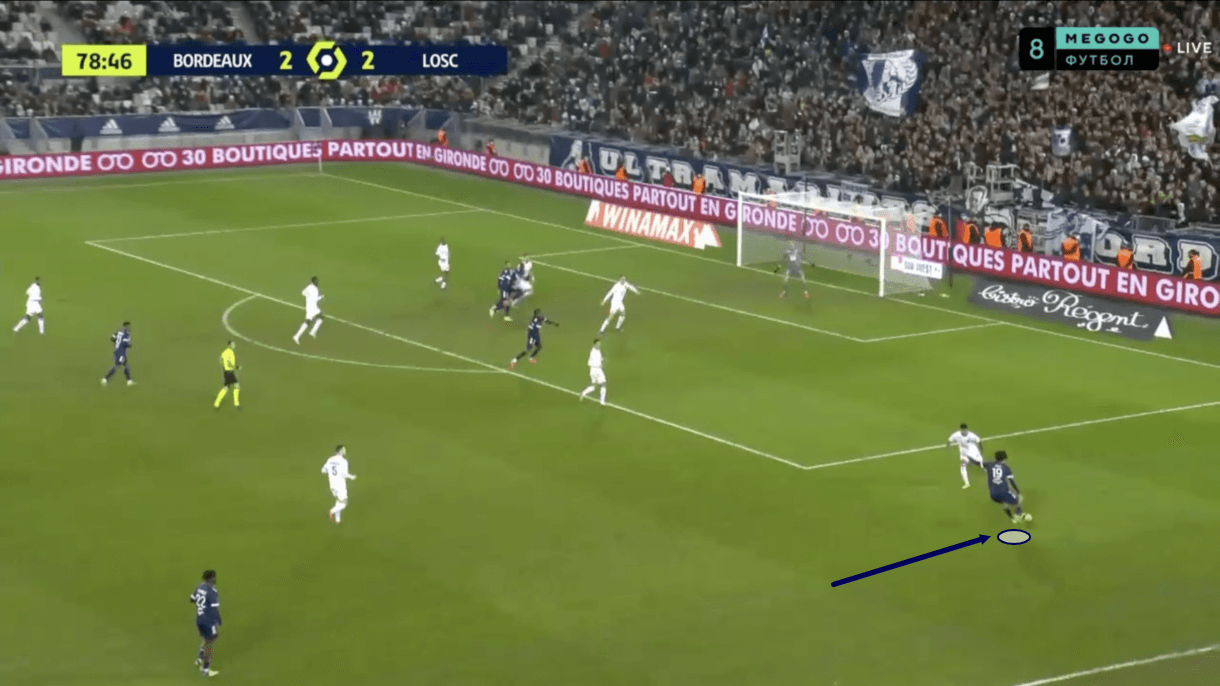
In figure 15, we see Adli charging down the right-wing, having picked up the ball just on the edge of the final third.
As he approaches the box, the playmaker shapes up as if he’s about to hit a cross, which wouldn’t be uncommon as Adli plays a fairly high number of crosses (1.72 per 90) for a central midfielder or attacking midfielder who usually operates in more central areas.
However, most of Adli’s crosses are in-swingers either coming from the left-wing or the left half-space and it’s not very common to see him in a traditional right-winger position to perform an out-swinging cross.
This passage of play actually provides another example of Adli’s impressive agility and ability to disguise his change of direction while shifting his weight from one foot to the other.
Here in figure 15, we see that the playmaker looks like he’s getting ready to loft a cross into the box from the right-wing.
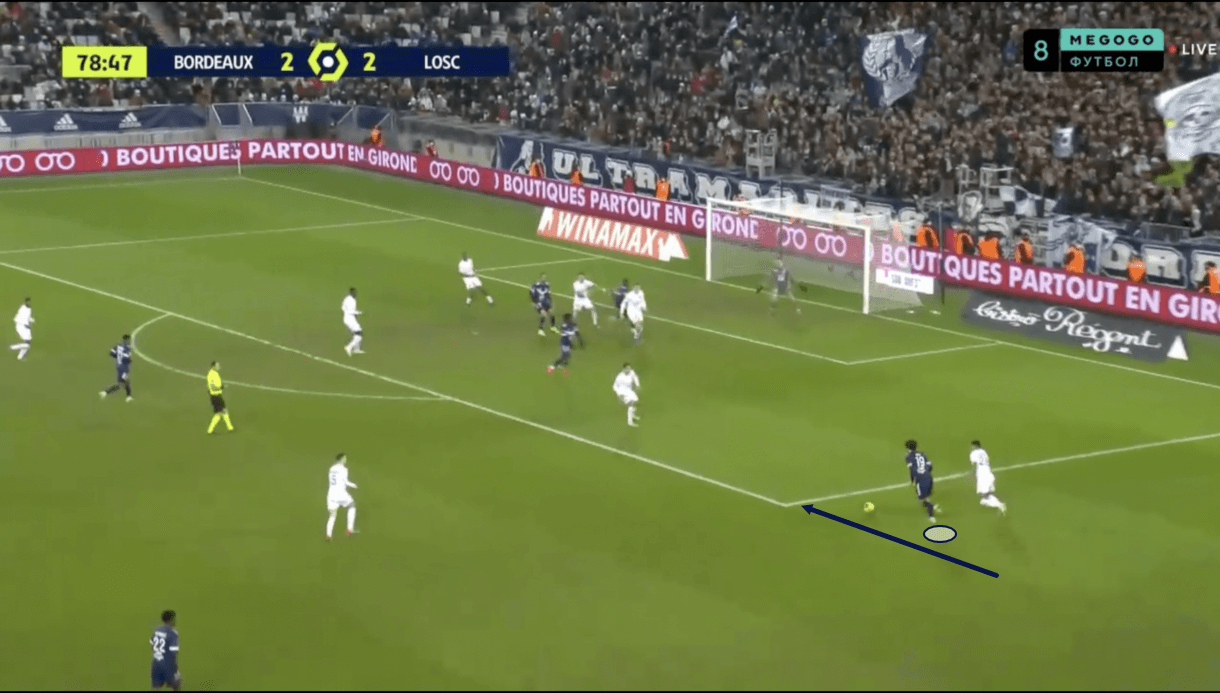
However, as the play progresses into Figure 16, we see that Adli didn’t release the cross and instead opted just to knock the ball inside the defender, targeting the space he’d left open just to the edge of the penalty box.
The midfielder follows the ball into the box, displaying his impressive agility by quickly turning and getting inside the defender far quicker than the full-back can turn. Previously, he had been facing in the complete opposite direction and anticipating an incoming cross.
As the play progresses, we see Adli break into the penalty area and create from a more central and threatening position, highlighting how his dribbling ability can be a major asset for his side in 1v1s.
This passage of play shows not only Adli’s agility but also his ability to change speed.
Even though he’s not extremely quick, he’s able to control his pace and shift between moving quickly and moving at a steadier pace.
Here, after slowing down when shaping up for the cross, Adli burst into speed after knocking the ball inside to ensure he got on the end of it and to ensure he left the full-back behind him.
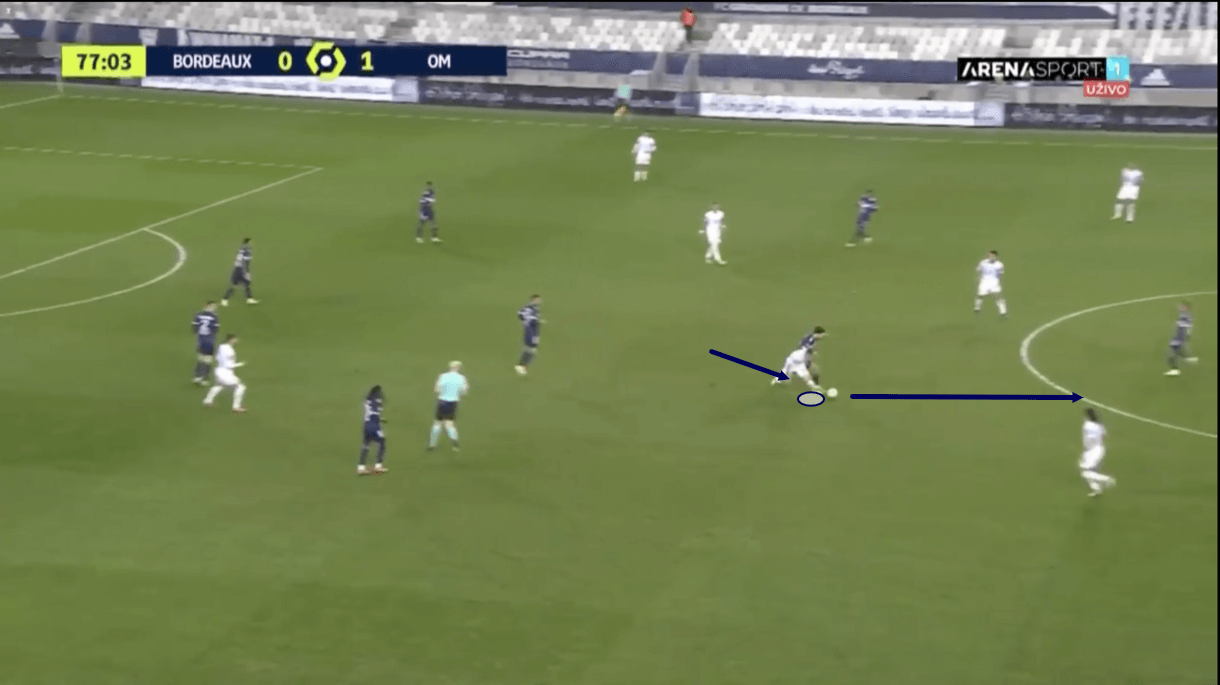
Lastly, at 186cm and 78kg, the playmaker is an impressive height and size for an agile dribbler.
As Figure 17 shows, Adli is well able to use his size and strength when carrying the ball to protect it from opposition players’ challenges and continue his run.
In Figure 17, he picks up the ball in a deeper area yet again before beginning to charge forward.
While carrying the ball forward, again, he attracted pressure towards him, which is typical for him, as we’ve already established.
However, on this occasion, Adli rose to the challenge and kept the defender away from the ball by using his large frame as a shield.
He successfully knocks the challenger down and continues to drive forward while maintaining his balance, indicating how comfortable Adli is with his size and strength.
Sometimes, you’ll see players of this size who seem not to know their own strength and fail to use it to their full potential, but that’s not the case with Adli, who’s comfortable using his body to protect the ball.
Of course, it’s not just about being strong and jumping into people.
Adli has to position his body intelligently to ensure he gets enough between the defender and the ball, which he achieves here in figure 17, while he must also have good balance not to get knocked off his stride from this contact, which he shows here by withstanding the initial contact from the defender and continuing to carry the ball into the opposition’s half, where he can try to create from a more threatening position.
Conclusion
To conclude this tactical analysis and scout report, I feel Milan fans should be excited by Adli’s mental development this season.
He’s clearly become more comfortable with being a leading man for a team in one of Europe’s top-five leagues, which may help him acclimatise a little more comfortably on arrival in Serie A, with a club of higher stature than relegation-battling Bordeaux at this current moment.
Adli is a versatile player with a very diverse skill set, as this scout report has shown.
However, I feel he’ll benefit from being given a more specified role within his team’s tactics as he continues his development.
For me, Adli may work best as an advanced ‘8’, though could equally perform well as a ‘10’ or as a left-sided inverted winger with the licence to occupy the left half-space in periods of possession.
I think this is the position he’ll ultimately fit into best during possession phases as his career continues. The playmaker will likely spend less time in the deeper positions we’ve seen him occupying at times this season.
However, that’s not to say Adli shouldn’t be given the ball deep on occasion, as his ball-carrying ability is too good to ignore.
This can be a great asset for his side in moments of transition when he’ll naturally be positioned deep with plenty of other bodies behind the ball.
Milan needs to be aware of his tendency to attract pressure towards him a bit too much in deeper areas when positioned there and perhaps get him more used to playing in a more limited role in terms of movement, which I believe could ultimately make him a more effective creative force for a team of higher quality with freedom within certain limits.





Comments